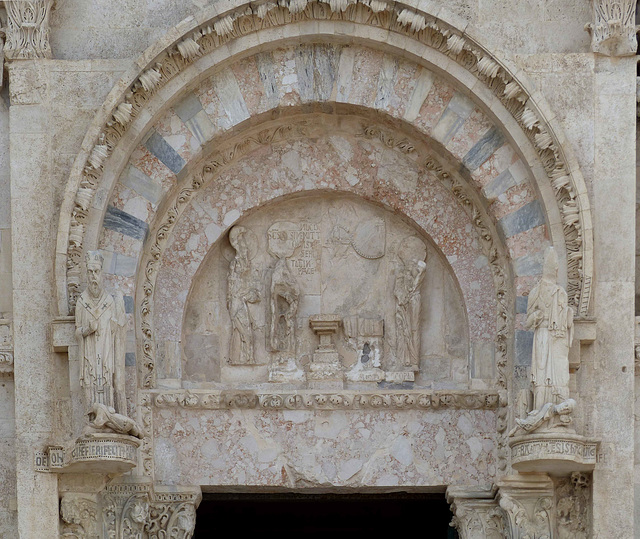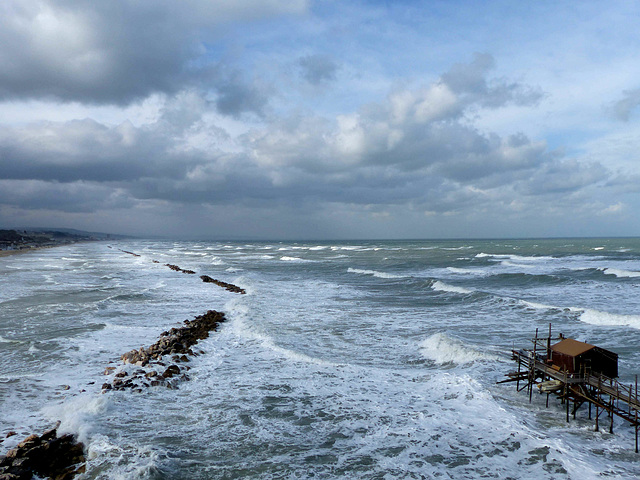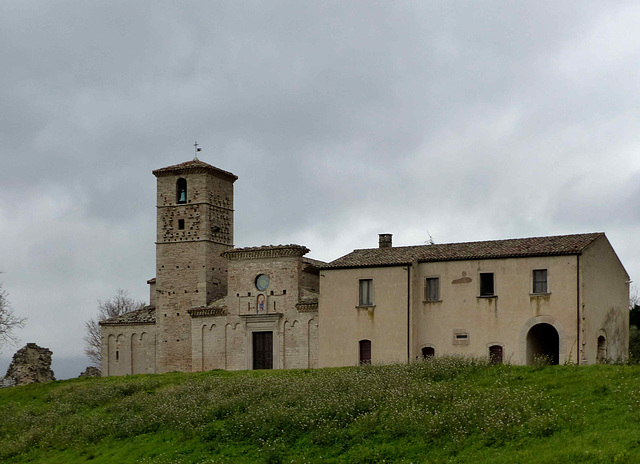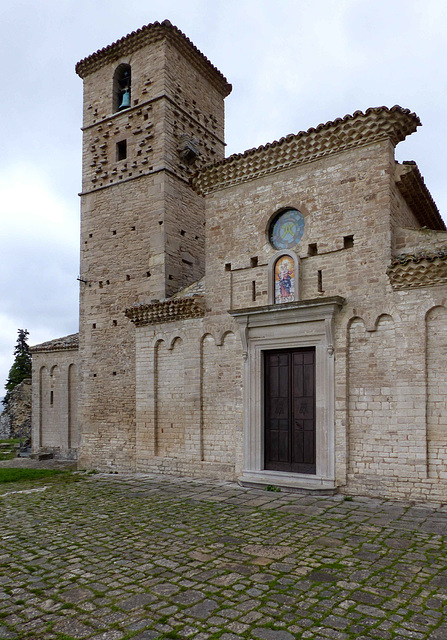
Molise
Molise is the youngest (1970) and second smallest region in Italy (after the Aosta Valley).
Termoli - Spiaggia di Rio Vivo
No beach life here in January
Termoli - Cattedrale di Santa Maria della Purificazione
Termoli is a city with a population of about 32.000, located in Molise, since 1970 the newest region in Italy.
Termoli was a Lombard county until the arrival of the Normans, under which it flourished and expanded.
The cathedral is the seat of the Bishop of Termoli-Larino.
The first church was built around the 6th century on the ruins of a temple. There is a reference to a larger church in 1037, a few years after a synod in 969, which was attended by the first bishop of Termoli. The present Romanesque building was constructed in the 12th and 13th centuries on the site of its predecessors and is attributed to Alfano da Termoli.
The cathedral was restored after an earthquake in 1464 and again after an attack by Ottoman Turks in 1566. During other renovation works in 1760 and 1962, the relics of Saint Bassus of Lucera and of Saint Timothy respectively, patron saints of the city of Termoli, were discovered.
The lower part of the facade corresponds to the original, Romanesque construction, the upper one comes from the restoration after the earthquake of 1456 and is Gothic.
Termoli - Cattedrale di Santa Maria della Purificazione
Termoli is a city with a population of about 32.000, located in Molise, since 1970 the newest region in Italy. Termoli was a Lombard county until the arrival of the Normans, under which it flourished and expanded.
The cathedral is the seat of the Bishop of Termoli-Larino.
The first church was built around the 6th century on the ruins of a temple. There is a reference to a larger church in 1037, a few years after a synod in 969, which was attended by the first bishop of Termoli. The present Romanesque building was constructed in the 12th and 13th centuries on the site of its predecessors and is attributed to Alfano da Termoli.
The cathedral was restored after an earthquake in 1464 and again after an attack by Ottoman Turks in 1566. During other renovation works in 1760 and 1962, the relics of Saint Bassus of Lucera and of Saint Timothy respectively, patron saints of the city of Termoli, were discovered.
The lower part of the facade corresponds to the original, Romanesque construction, the upper one comes from the restoration after the earthquake of 1456 and is Gothic.
The tympanum is quite damaged
Termoli - Cattedrale di Santa Maria della Purificazione
Termoli is a city with a population of about 32.000, located in Molise, since 1970 the newest region in Italy. Termoli was a Lombard county until the arrival of the Normans, under which it flourished and expanded.
The cathedral is the seat of the Bishop of Termoli-Larino.
The first church was built around the 6th century on the ruins of a temple. There is a reference to a larger church in 1037, a few years after a synod in 969, which was attended by the first bishop of Termoli. The present Romanesque building was constructed in the 12th and 13th centuries on the site of its predecessors and is attributed to Alfano da Termoli.
The cathedral was restored after an earthquake in 1464 and again after an attack by Ottoman Turks in 1566. During other renovation works in 1760 and 1962, the relics of Saint Bassus of Lucera and of Saint Timothy respectively, patron saints of the city of Termoli, were discovered.
The lower part of the facade corresponds to the original, Romanesque construction, the upper one comes from the restoration after the earthquake of 1456 and is Gothic.
One of the side niche arches of the facade
Termoli - Cattedrale di Santa Maria della Purificazione
Termoli is a city with a population of about 32.000, located in Molise, since 1970 the newest region in Italy. Termoli was a Lombard county until the arrival of the Normans, under which it flourished and expanded.
The cathedral is the seat of the Bishop of Termoli-Larino.
The first church was built around the 6th century on the ruins of a temple. There is a reference to a larger church in 1037, a few years after a synod in 969, which was attended by the first bishop of Termoli. The present Romanesque building was constructed in the 12th and 13th centuries on the site of its predecessors and is attributed to Alfano da Termoli.
The cathedral was restored after an earthquake in 1464 and again after an attack by Ottoman Turks in 1566. During other renovation works in 1760 and 1962, the relics of Saint Bassus of Lucera and of Saint Timothy respectively, patron saints of the city of Termoli, were discovered.
The nave
Termoli - Castello Svevo
Termoli is a city with a population of about 32.000, located in Molise, since 1970 the newest region in Italy. Termoli was a Lombard county until the arrival of the Normans, under which it flourished and expanded.
The architecture of the Castello Svevo is characterized by great simplicity, without any ornamentation, and its defensive features indicate that it was built in the Norman period (11th century) near a pre-existing Lombard tower. However, it is defined as Swabian after the restructuring and fortification commissioned by Frederick II of Swabia in 1240, following the damage caused by an attack by the Venetian fleet. Due to its location, it was the hub of a larger defense system that consisted of a sturdy wall that surrounded the entire perimeter of the city.
Trabucco
The trabucco (also called bilancia) is an ancient fishing machine typical of the coasts of Abruzzo and Molise. The purpose of this construction is to lower a large rectangular net evenly horizontally and to raise it again after some time. Trabucchi were built on suitable stretches of coastline, in places where shoals of fish pass.
Morrone del Sannio - Santa Maria Di Casalpiano
After the end of the Roman Empire, the quite populated area was under Gothic and Byzantine rule. Already around 500 there were monasteries here, as papal letters prove. The Longobards followed and around 1000 there must have been two churches in Casalpiano.
In the archaeological area of Casalpiano the remains of a Roman villa were discovered. However, the area was turned into a necropolis and to date more than 50 graves have been discovered. Of the two churches, that existed (Santa Maria and Santa Apollinare) only Santa Maria still exists, but the current church was probably built between in the 13th century. On the side of the current church are the monumental remains of another sacred building, the dating of which is still uncertain given the considerable size and height of the buildings.
Morrone del Sannio - Santa Maria Di Casalpiano
After the end of the Roman Empire, the quite populated area was under Gothic and Byzantine rule. Already around 500 there were monasteries here, as papal letters prove. The Longobards followed and around 1000 there must have been two churches in Casalpiano.
In the archaeological area of Casalpiano the remains of a Roman villa were discovered. However, the area was turned into a necropolis and to date more than 50 graves have been discovered. Of the two churches, that existed (Santa Maria and Santa Apollinare) only Santa Maria still exists, but the current church was probably built between in the 13th century. On the side of the current church are the monumental remains of another sacred building, the dating of which is still uncertain given the considerable size and height of the buildings.
Jump to top
RSS feed- Latest items - Subscribe to the latest items added to this album
- ipernity © 2007-2025
- Help & Contact
|
Club news
|
About ipernity
|
History |
ipernity Club & Prices |
Guide of good conduct
Donate | Group guidelines | Privacy policy | Terms of use | Statutes | In memoria -
Facebook
Twitter










